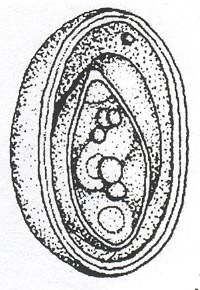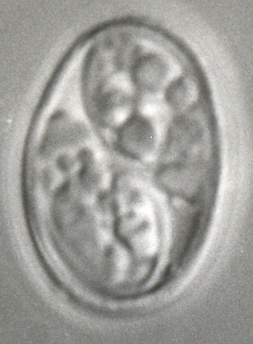Isospora cristatae Duszynski, 1989
Type host: Condylura cristata (Linnaeus, 1758), Star-nosed mole.
Other hosts: None reported to date.
Type locality: NORTH AMERICA: USA, Ohio, Ashtabula Co., Ashtabula, 2302 Morningside Drive.
Geographic distribution: NORTH AMERICA: USA, Maine, Massachusettes, Ohio, Vermont.


Description of oocyst:
Oocyst shape: ellipsoid, sometimes slightly asymmetrical;
number of walls: 2;
wall thickness: ~1.0;
wall characteristics: outer layer smooth, ~1.2 of total thickness; inner, smooth;
L x W: 15.7 x 10.1 (13-18 x 9-13);
L/W ratio: 1.55 (1.35-1.8);
M: absent;
OR: absent;
PG: 1, small.
Distinctive features of oocyst: ellipsoid shape and small PG.
Description of sporocysts and sporozoites:
Sporocyst shape: ovoid;
L x W: 11.0 x 5.7 (10-12 x 5-7);
L/W ratio: 1.9 (1.6-2.1);
SB: present;
SSB: present, >2 times wider than SB;
PSB: absent;
SR: present;
SR characteristics: 2-8 dispersed globules;
SP: with 1 visible RB in posterior half.
Distinctive features of sporocyst: SSB >2 times wider than SB.
Prevalence: 19/24 (79%), including 9/12 (75%) from Vermont, 5/6 (83%) from Ohio, 3/4 (75%) from Massachusetts, and 2/2 (100%) from Maine.
Sporulation: Exogenous. Oocysts sporulated in 7-10 days in 2.5% aqueous (w/v) potassium dichromate solution at ~23 C.
Prepatent and patent periods: Unknown.
Site of infection: Unknown. Oocysts recovered from feces and intestinal contents.
Materials deposited: Skin, skull, skeleton and tissues of the symbiotype host are preserved in the Mammal Division of the Museum of SW Biology, UNM: MSB No. 43403 (NK 3112, male), R.M. Sullivan #512, 28 June, 1980. Photosyntypes in the USNPC No. 80627.
Remarks: Sporulated oocysts of this species are similar in size and shape to those of I. dymecodi Duszynski and Moore, 1986 and I. sporopointaea Duszynski and Wattam, 1988. They differ from the former by having a larger L/W ratio (1.55 vs 1.25) and by having sporocysts with both SB and SSB that those of I. dymecodi lack. They differ from the latter by having a smooth outer wall (vs mammillated), by having a PG (vs none), having sporocysts rounded at the end opposite the SB (vs pointed),and by having a SSB that is twice as wide as the SB (vs equal in width).
References: Duszynski (1989).



